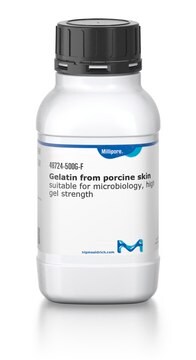39465
Gelatine aus Schweinehaut
suitable for microbiology, ultrahigh gel strength
Anmeldenzur Ansicht organisationsspezifischer und vertraglich vereinbarter Preise
Alle Fotos(1)
About This Item
Empfohlene Produkte
Biologische Quelle
Porcine
Qualitätsniveau
Form
powder
Qualität
ultrahigh gel strength
Haltbarkeit
limited shelf life, expiry date on the label
Verlust
9.5-12.5% loss on drying
Durchlässigkeit
450 nm, ≥85%
620 nm, ≥95%
pH-Wert
5.20-5.60
Leitfähigkeit
120-190 μS/cm at 30 °C (1%)
Viskosität
5.10-5.80 mPa.s
Gelstärke
280-302 g BloomAOAC
Löslichkeit
H2O: 67 mg/mL at 60 °C
Kationenspuren
Ca: ≤100 mg/kg
Anwendung(en)
microbiology
Suchen Sie nach ähnlichen Produkten? Aufrufen Leitfaden zum Produktvergleich
Verwandte Kategorien
Anwendung
This product is recommended for use as a cell culture substratum at 1-5 μg/cm2 or 0.5-50 μg/mL. The optimal concentration does depend on cell type as well as the application and research objectives.
Gelatin has been used in many applications. It has use in coating cell culture to improve attachment of cells, being added to PCR to stabilize Taq DNA, as a blocking reagent in Western blotting, ELISA, and immunochemistry, and as a component of media for species differentiation in bacteriology. As a biocompatible polymer, it has used as a delivery vehicle for release of active biomolecules and in generation of scaffolds for tissue engineering applications. In the pharmaceutical industry, geltan can be used as a suspending and encapsulating agent, among other applications.
Gelatin has been used in many applications. It has use in coating cell culture to improve attachment of cells, being added to PCR to stabilize Taq DNA, as a blocking reagent in Western blotting, ELISA, and immunochemistry, and as a component of media for species differentiation in bacteriology. As a biocompatible polymer, it has used as a delivery vehicle for release of active biomolecules and in generation of scaffolds for tissue engineering applications. In the pharmaceutical industry, geltan can be used as a suspending and encapsulating agent, among other applications.
Komponenten
Gelatine ist ein heterogenes Gemisch aus wasserlöslichen Proteinen mit hoher mittlerer Molekularmasse, das in Kollagen vorhanden ist. Die Proteine werden mittels Sieden der relevanten Haut, Sehnen, Ligamente, Knochen usw. in Wasser extrahiert. Gelatine vom Typ A wird aus mit Säure aufgeschlossenem Gewebe gewonnen. Gelatine vom Typ B wird aus mit Kalklauge geäschertem Gewebe gewonnen.
Vorsicht
Dry gelatin, when stored in airtight containers at room temperature, will remain unchanged for many years. When heated at 100°C in the presence of air, it swells becomes soft and disintegrates to a carbonaceous mass with evolution of pyridine bases and ammonia.
Angaben zur Herstellung
This product is derived from porcine skin. Gelatin is soluble in hot than in cold water. It is practically insoluble in most organic solvents such as alcohol, chloroform, carbon disulfide, carbon tetrachloride, ether, benzene, acetone, and oils. The Bloom number, determined by the Bloom gelometer, is an indication of the strength of a gel formed from a solution of the known concentrat ion. The Bloom number is proportional to the average molecular mass. Bloom numbers of porcine skin Gelatin vary from 90 to 300 g. Manufactured by Gelita AG
Lagerklassenschlüssel
11 - Combustible Solids
WGK
nwg
Flammpunkt (°F)
Not applicable
Flammpunkt (°C)
Not applicable
Hier finden Sie alle aktuellen Versionen:
Besitzen Sie dieses Produkt bereits?
In der Dokumentenbibliothek finden Sie die Dokumentation zu den Produkten, die Sie kürzlich erworben haben.
Kunden haben sich ebenfalls angesehen
M V Nasekin et al.
Anesteziologiia i reanimatologiia, (1)(1), 59-60 (2013-07-03)
The article deals with skills improving problem of epidural anaesthesia with ultrasound control. Methods of gelatin spinal column model making, use and its economical side are discussed in the article.
Johno Breeze et al.
Journal of the Royal Army Medical Corps, 159(2), 84-89 (2013-05-31)
Ballistic gelatin is the most common tissue simulant used to reproduce the penetration of projectiles into muscle but published data to support its use are primarily based on bullets, despite explosive fragments being the most common cause of injury to
Takeo Furuya et al.
The journal of spinal cord medicine, 36(2), 134-139 (2013-07-03)
Besides stimulating angiogenesis or cell survival, basic fibroblast growth factor (bFGF) has the potential for protecting neurons in the injured spinal cord. To investigate the effects of a sustained-release system of bFGF from gelatin hydrogel (GH) in a rat spinal
Monica A Serban et al.
Methods in molecular biology (Clifton, N.J.), 1001, 133-143 (2013-03-16)
Tissue engineering involves the concerted action of biomaterials, cells, and growth factors. Kidney -regeneration relies on the same combination of ingredients. Here, we describe an example of gelatin-based biomaterial preparation and its evaluation in the context of kidney biocompatibility and
Nina E Lamash et al.
PloS one, 8(3), e58433-e58433 (2013-03-19)
Four proteases with molecular masses of 132, 58, 53, and 47 kDa were detected in the digestive system of the holothurian Eupentacta fraudatrix. These proteases displayed the gelatinase activity and characteristics of zinc metalloproteinases. The 58 kDa protease had similar
Unser Team von Wissenschaftlern verfügt über Erfahrung in allen Forschungsbereichen einschließlich Life Science, Materialwissenschaften, chemischer Synthese, Chromatographie, Analytik und vielen mehr..
Setzen Sie sich mit dem technischen Dienst in Verbindung.
